GraphQL vs. REST APIs: Which Should You Choose?

GraphQL vs. REST APIs: Which Should You Choose?
Understanding REST APIs
REST (Representational State Transfer) is an architectural style for designing networked applications. It relies on a stateless, client-server communication protocol, usually HTTP. RESTful APIs expose resources as endpoints and employ standard HTTP methods—GET, POST, PUT, DELETE—to perform operations on these resources.
Key Features of REST:
- Resource-Based: Resources are the primary focus, identified by URLs.
- Stateless: Each request from a client contains all information needed by the server to fulfill it.
- Caching: HTTP caching mechanisms can be leveraged.
- Layered System: Architecture can be composed of hierarchical layers for scalability.
REST API Example
GET /users/123
This request retrieves a user resource with the ID 123.
Exploring GraphQL
GraphQL is a query language and runtime for APIs, developed by Facebook. It allows clients to request only the data they need, making it more efficient in terms of network usage and data management.
Key Features of GraphQL:
- Single Endpoint: All operations are performed through a single endpoint.
- Client-Specified Queries: Clients specify the structure of the response.
- Strongly Typed: Schema defines types and fields.
- Real-Time Data: Supports subscriptions for real-time updates.
GraphQL API Example
{
user(id: "123") {
name
email
}
}
This query fetches only the name and email fields of a user with the ID 123.
Comparing REST and GraphQL
| Feature | REST | GraphQL |
|---|---|---|
| Data Fetching | Fixed endpoints, multiple calls | Single query, one call |
| Flexibility | Limited by endpoint | Highly flexible, client-defined |
| Over-fetching | Possible due to fixed responses | Avoided by querying specific data |
| Under-fetching | Possible if multiple resources needed | Avoided with nested queries |
| Versioning | Required for changes | Not necessary, evolve fields |
| Tooling | Mature, diverse tools | Growing, innovative tools |
| Learning Curve | Familiar to most developers | Steeper due to new concepts |
Use Cases and Decision Factors
When to Use REST:
- Simplicity and Familiarity: If the team is already familiar with REST, leveraging existing knowledge can speed up development.
- Caching: When HTTP caching is a priority for performance.
- Stateless Operations: If operations are straightforward and stateless, REST might be a simpler choice.
- Existing Infrastructure: If existing systems are RESTful, it might be more efficient to continue in that style.
When to Use GraphQL:
- Complex Data Requirements: When clients need to fetch varying data sets with different structures.
- Single Endpoint Requirement: If simplifying network architecture to a single endpoint is beneficial.
- Reduced Over/Under Fetching: When network efficiency is a priority.
- Rapid Iteration: If the API needs to evolve quickly without breaking changes.
- Real-Time Functionality: For applications requiring real-time data updates.
Implementing REST and GraphQL
REST API Implementation
A simple REST API using Node.js and Express might look like this:
const express = require('express');
const app = express();
app.get('/users/:id', (req, res) => {
const userId = req.params.id;
// Fetch user from the database
res.json({ id: userId, name: 'John Doe' });
});
app.listen(3000, () => {
console.log('REST API running on port 3000');
});
GraphQL API Implementation
A basic GraphQL server setup using Express and graphql-express:
const express = require('express');
const { graphqlHTTP } = require('express-graphql');
const { buildSchema } = require('graphql');
const schema = buildSchema(`
type User {
id: ID!
name: String
}
type Query {
user(id: ID!): User
}
`);
const root = {
user: ({ id }) => {
return { id: id, name: 'John Doe' };
},
};
const app = express();
app.use('/graphql', graphqlHTTP({
schema: schema,
rootValue: root,
graphiql: true,
}));
app.listen(4000, () => {
console.log('GraphQL API running on port 4000');
});
Conclusion: Making the Choice
The decision between REST and GraphQL should be guided by the specific needs of your project and team capabilities. Consider aspects such as data complexity, team expertise, and performance requirements. Both REST and GraphQL are powerful tools, and understanding their strengths and trade-offs will enable you to enhance your API strategy effectively.





0 thoughts on “GraphQL vs. REST APIs: Which Should You Choose?”